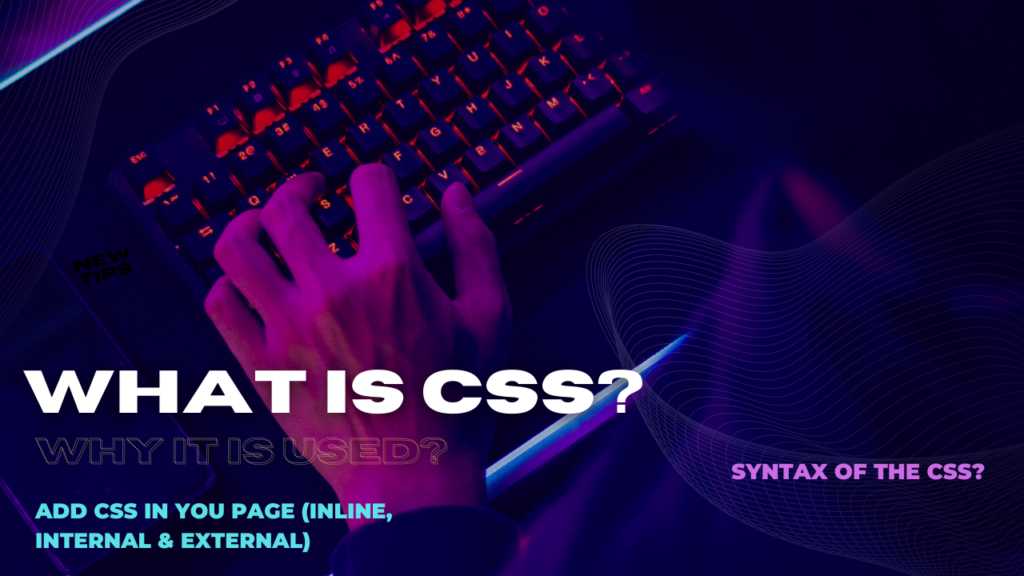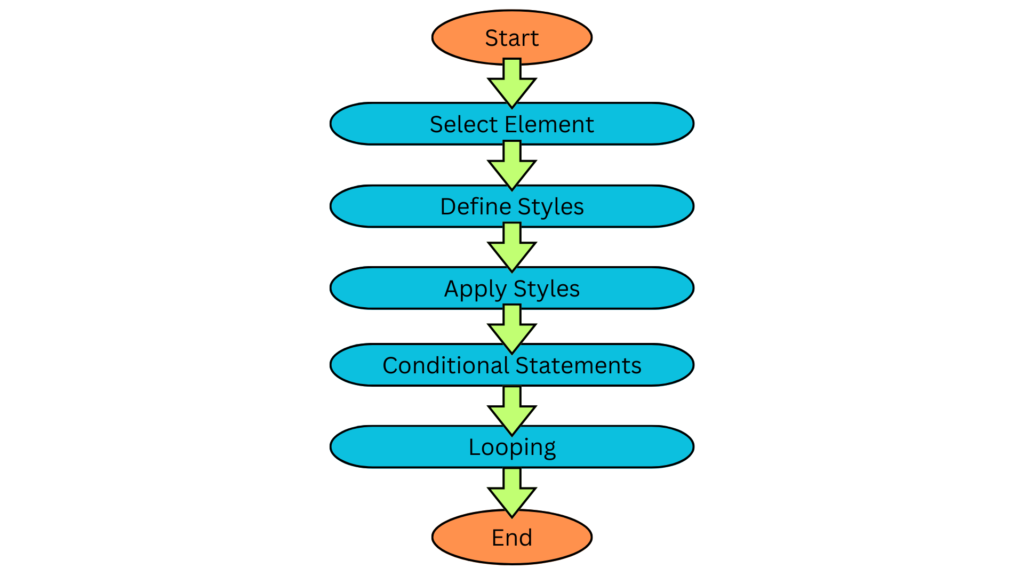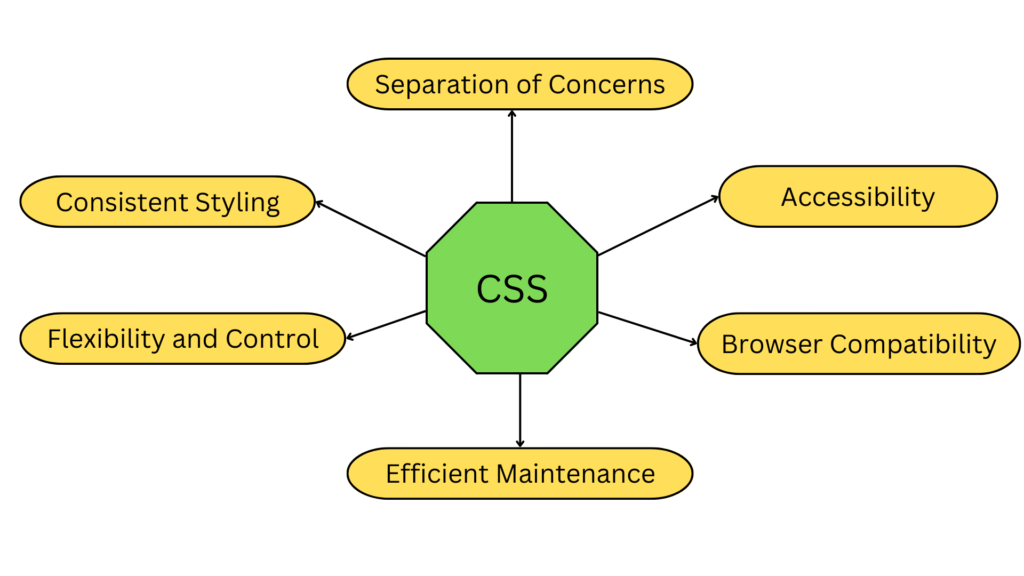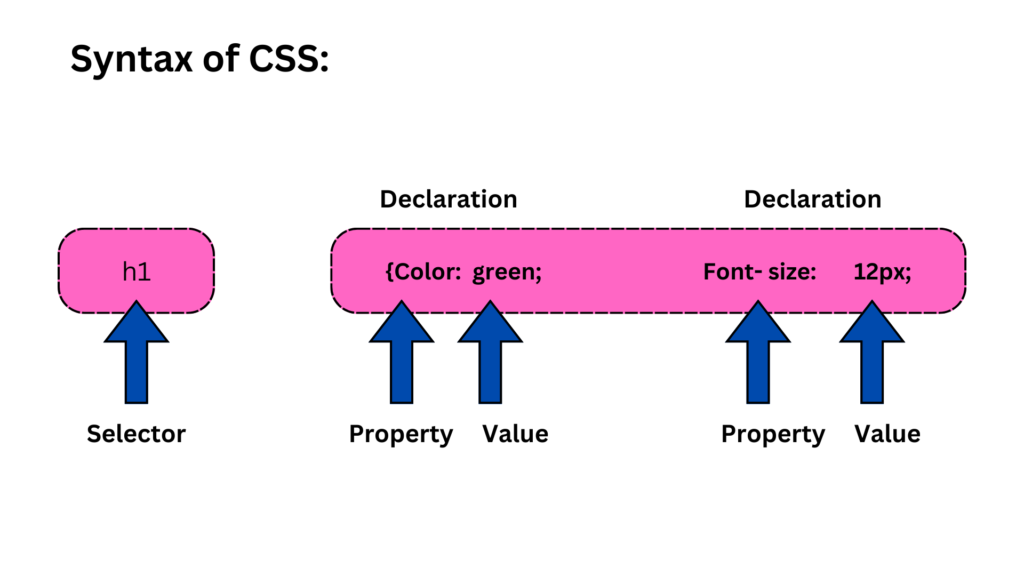
1. Cascading Style Sheet (CSS)
CSS, short for Flowing Templates, is a styling language used to depict the visual show of a record written in markup dialects like HTML or XML. It gives a method for isolating the design and content of a report from its visual portrayal, permitting engineers to control the appearance and design of site pages. CSS works by partner style rules with HTML components. These standards characterize how the components ought to be shown on the screen or in different media. A CSS rule comprises of a selector and a statement block. The selector focuses on the HTML element(s) to which the styles ought to be applied, while the statement block contains a bunch of property-estimation coordinates that characterize explicit visual traits.
CSS offers an extensive variety of styling choices, including changing text and foundation tones, changing text style styles and sizes, modifying edges and cushioning, situating components, making liveliness, and substantially more. It gives a strong and adaptable method for redoing the look and feel of a site, guaranteeing consistency across various pages. One of the critical advantages of CSS is its capacity to isolate style from structure. By keeping the show separate from the substance, engineers can undoubtedly refresh the plan of a site without changing the fundamental HTML code. This partition additionally considers better viability and reusability of styles across various pages, bringing about more productive improvement work processes.
CSS has developed throughout the long term, with the most recent adaptation being CSS3. It presented many new highlights and improvements, including support for media inquiries for responsive plan, high level design choices with flexbox and network frameworks, changes and activities for intuitive components, and substantially more. These progressions have made CSS a necessary piece of present day web improvement, empowering designers to make outwardly dazzling and dynamic sites. All in all, CSS is a strong styling language that permits engineers to control the visual show of site pages. With its capacity to isolate style from structure, CSS gives adaptability, viability, and reusability, making it a fundamental device for making drawing in and stylishly satisfying sites.
Flowchart of CSS

Example:
/* CSS Stylesheet */
/* Select the <h1> element and change its text color */
h1 {
color: blue;
}
/* Select all <p> elements and set their font size and line height */
p {
font-size: 16px;
line-height: 1.5;
}
/* Select the element with the class "button" and style it as a button */
.button {
display: inline-block;
padding: 10px 20px;
background-color: #4CAF50;
color: white;
text-decoration: none;
border-radius: 4px;
}
/* Apply different styles when the button is hovered over */
.button:hover {
background-color: #45a049;
}
/* Select the element with the ID "container" and center its contents */
#container {
text-align: center;
}
In this Example:
- The h1 selector targets all <h1> elements and sets their text color to blue.
- The p selector targets all <p> elements and adjusts their font size to 16 pixels and line height to 1.5.
- The .button selector targets elements with the class “button” and styles them as buttons, including background color, padding, text color, and border radius.
- The .button:hover selector applies a different background color when the button is hovered over.
- The #container selector targets the element with the ID “container” and centers its contents by setting the text alignment to center.
Use Of CSS:
CSS, short for Flowing Templates, is utilized in web improvement to control the visual show and styling of site pages. It assumes a significant part in making appealing, predictable, and easy to understand sites. Here are a few key justifications for why CSS is utilized:
Flowchart:

Separation of Concerns: CSS takes into consideration an unmistakable partition of the design (HTML) and the show (CSS) of a website page. This division improves code practicality, as changes to the plan can be made freely of the substance. It advances particular turn of events and permits different colleagues to at the same time chip away at the HTML and CSS perspectives.
Consistent Styling: CSS empowers predictable styling across a site. Designers can characterize styles for explicit HTML components, classes, or IDs, and these styles can be applied reliably across different pages. By utilizing outside CSS records, changes to the styling can be made in one spot, influencing all pages utilizing that CSS document. This outcomes in a firm and expert looking site.
Flexibility and Control: CSS offers an extensive variety of styling choices, permitting designers to control the presence of components definitively. Properties like tones, textual styles, edges, cushioning, lines, and design situating can be acclimated to accomplish the ideal special visualizations. CSS additionally upholds media questions, empowering responsive plan for various screen sizes and gadgets.
Efficient Maintenance: With CSS, site upkeep turns out to be more proficient. In the event that an adjustment of plan or style is required, it tends to be finished by changing the CSS code without contacting the fundamental HTML structure. This saves time and exertion, particularly for enormous sites or ventures with successive updates.
Browser Compatibility: CSS helps address the test of program similarity. Different internet browsers might have fluctuating translations of HTML, however CSS gives a reliable method for styling pages across various programs. It permits designers to compose code that is viable with numerous programs, decreasing the requirement for program explicit hacks or workarounds.
Accessibility: CSS empowers the production of open sites. It gives highlights like responsive designs, clear visual progressive system, legitimate variety contrast, and the capacity to redo text dimensions. These highlights add to further developed openness for clients with handicaps, guaranteeing that the site content is usable and lucid for all guests.
What is the Syntax of CSS?
CSS (Cascading Style Sheets) is a language used to portray the visual show of a report written in HTML or XML. It gives a bunch of decides and properties that characterize how components in a report ought to be shown on the screen, on paper, or different media types. The punctuation of CSS is moderately clear, comprising of selectors, properties, and values.
Selectors are utilized to target explicit components in a HTML record that you need to style. They can be founded on component names, class names, IDs, traits, or even the connection between components. For instance, you can utilize the selector “h1” to focus on all heading level 1 components in the archive.
Properties are utilized to characterize the particular parts of a component that you need to style, for example, variety, text dimension, cushioning, or foundation picture. Every property has a comparing esteem that decides how that property ought to be applied. For instance, the property “variety” can have a worth of “red,” “blue,” or some other substantial variety esteem.
CSS rules are made by consolidating selectors and properties. Different guidelines can be gathered inside a CSS record or installed inside a HTML report utilizing the <style> tag. It’s additionally conceivable to apply styles inline utilizing the style property inside HTML labels.
CSS syntax follows a simple structure:
selector {
property1: value1;
property2: value2;
/* Additional properties and values */
}
Each rule starts with a selector, followed by a set of properties and their corresponding values enclosed in curly braces. Multiple properties are separated by semicolons.
In summary, CSS syntax consists of selectors, properties, and values. Selectors determine which elements to style, while properties and values define the visual appearance of those elements. By utilizing CSS, web developers can effectively control the layout and design of web pages, resulting in visually appealing and consistent user experiences.

Example:
/* CSS comment - This is a comment that is ignored by the browser */
/* Select the 'h1' element and apply styles */
h1 {
color: green;
font-size: 12px;
text-align: center;
}
/* Select the elements with class 'button' and apply styles */
.button {
background-color: green;
color: white;
padding: 10px 20px;
border-radius: 5px;
}
/* Select the element with ID 'logo' and apply styles */
#logo {
width: 200px;
height: 150px;
background-image: url('logo.png');
background-size: cover;
}
/* Select elements with attribute 'type' set to 'text' and apply styles */
input[type="text"] {
border: 1px solid gray;
padding: 5px;
}
/* Select the first paragraph inside a div with class 'content' and apply styles */
div .content p:first-of-type {
font-weight: bold;
}
In this example, we have different CSS rules targeting various elements. The selector defines which elements the styles should be applied to, followed by a set of properties and values within curly braces. Each property is separated by a semicolon.
For instance, the first rule selects all h1 elements and sets the text color to blue, font size to 24 pixels, and aligns the text to the center. The second rule targets elements with the class button and styles them with a green background, white text color, padding, and border radius. The #logo rule applies styles to an element with the ID logo, including the background image, dimensions, and background size.
Additionally, there is a rule that selects input elements with the attribute type set to “text”, applying styles such as a gray border and padding. Lastly, the rule with the complex selector selects the first paragraph inside a div element with the class content and sets the font weight to bold.
CSS syntax allows developers to specify styles for different elements in a structured and readable manner, making it easier to maintain and update the appearance of a website or application.
How To Add CSS in You Page (Inline, Internal, External)
With regards to styling pages, CSS (Flowing Templates) assumes a critical part in characterizing the visual show. CSS can be added to a page in three distinct ways: inline, inward, and outer. Every technique enjoys its own benefits and use cases, permitting engineers to pick the most proper methodology for their particular requirements.
Inline CSS: Inline CSS includes adding style straightforwardly to individual HTML components utilizing the style quality. This strategy is reasonable for making speedy, explicit changes to a solitary component. For instance, to change the shade of a section, you can add style=”color: red;” to the <p> tag.
Example:
<p style="color: blue; font-size: 18px;">This is a paragraph with inline CSS.</p>
Internal CSS: Inside CSS is put inside the <style> labels in the <head> part of a HTML archive. This technique permits you to characterize styles for various components in a solitary report. Selectors and styles are composed inside the <style> labels, giving a cleaner detachment among HTML and CSS. To apply styles, you use selectors and statements very much like in an outer CSS document.
Example:
<!DOCTYPE html>
<html>
<head>
<title>Internal CSS Example</title>
<style>
body {
font-family: Arial, sans-serif;
background-color: #f2f2f2;
}
h1 {
color: blue;
text-align: center;
}
p {
color: red;
font-size: 18px;
}
</style>
</head>
<body>
<h1>Welcome to my Website</h1>
<p>This is an example of internal CSS. The styles defined within the <style> tag in the <head> section are applied to the respective elements on this page.</p>
<p>Internal CSS provides a convenient way to apply styles to multiple elements within a single HTML document.</p>
</body>
</html>
External CSS: Outer CSS includes making a different CSS record and connecting it to your HTML report utilizing the <link> tag. This technique is great for keeping up with consistency across various pages, as a similar CSS record can be connected to all pertinent pages. By keeping styles separate from HTML, it considers simpler administration and refreshing of styles across the whole site.
Example:
h1 {
color: blue;
font-size: 24px;
}
p {
color: green;
}
Conclusion: Adding CSS to your site page is fundamental for accomplishing wanted visual styles and designs. Inline CSS is valuable for fast, explicit changes, interior CSS empowers styling inside a solitary report, and outer CSS advances consistency and reasonability across numerous pages. Understanding these three techniques enables web designers to actually control the introduction of their sites and make outwardly engaging client encounters. Pick the strategy that best suits your necessities and coding practices to rejuvenate your plans.